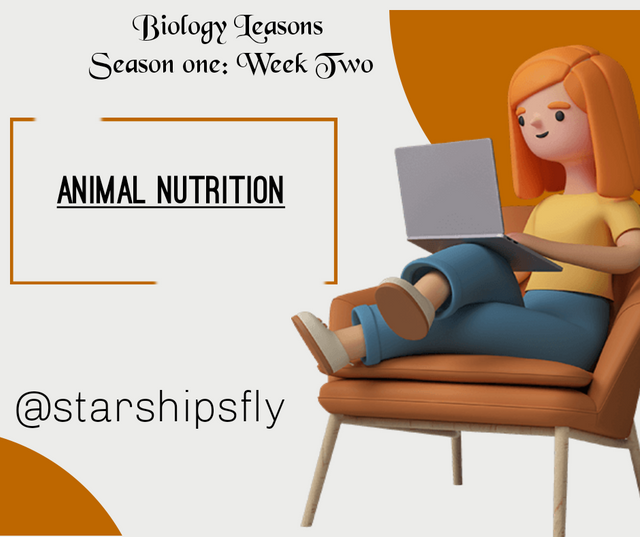Biology Lessons|Season One :Week Two|| Animal Nutrition by @starshipsfly

image edited with brand maker app
Greetings to all great students and teachers of steem skilshare. Welcome to yet another biology lesson today. We will be discussing Animal nutrition
Classification of Animals based on their nutrition.
They are classified into three groups.
Carnivorous animals: these are animals that feed on only flesh from other animals. Animal like,lion, tiger etc.
Herbivorous Animals: these are animals that feed on only plants. Examples are sheep, cattle, goat,etc.
Omnivorous Animals: these types of animals feed on both animals and plants. Examples are Man, pig etc.
Classification of food substances.
All food substances eaten by animals are classified into seven different groups. Six which is commonly known to us.
They are
- Carbohydrates
- Protien
- Fats and oils
- Vitamin
- Mineral salts
- Water
- Roughages
Carbohydrates: it is usually present in solid starchy foods. Carbohydrates are made up of carbon, hydrogen and oxygen. That's is why the general formula if carbohydrate is Cx(H20)y.
Sources of carbohydrates:
carbohydrate is present in foods like, yam, maize,Millet, Guinea corn, potatoes etc they are a rich source of carbohydrates.
Types of carbohydrates
Carbohydrates are classified into three major types
Monosaccharides: they are also called simple sugars as they have only one unit of simple sugars. They have a general formula of C6H12O6.
Examples are: glucose galactose and fractoseDisaccharides: they are also known as reducing sugars as they contain two units of simple sugars. They a general formula of C12H22O11
Examples are: lactose, maltose, sucrose.Polysaccharides : the consists of more than two simple sugars all they are made up of several simple sugars that are joined together. It is represented by the general formula in brackets (C6H10O5n) where n represents a large number of simple sugars. Examples are starch, chitin, glycogen and cellulose.
Excess carbohydrate is stored in the body in form of glycogen and it can be recovered to glucose during starvation they are stored especially in the muscles and liver.
Importance of carbohydrates
- Carbohydrates is a great source of energy to animals that is needed to carry out their daily activities.
- During the oxydation of carbohydrates, heat is generated and this helps in the regulation of body temperature.
- Carbohydrates are essential to help build up certain body parts like the exoskeleton of arthropods which is made up of chitin.
Proteins
Sources of protein: plants like beans, groundnut and soyabean etc are goods sources of protein. Protein is also sources from dairy products from animals like cheese, milk, beef and chicken etc
Importance of protein
- Protein is essential for the growth of young animals.
- It helps reproduction.
- It is essential for the Formation of cells and tissues and also helps repair of worn out cells abd tissues in the body.
- It is important in the production of hormones.
Fats and oils
Mineral salts
Classes of mineral salts and functions
There are different types of minerals and their functions
Calcium: it helps in bone and teeth formation
Phosphorus helps in the formation of DNA and RNA and is important for respiration
Magnesium is good for the muscles, teeth and bones.
Pottasuim helps transmit impulses in nerves.
Sodium and chlorine is important for the maintenance of osmotic Ballance of cells.
Iron is essential for the formation of haemoglobin.
And other minerals like
Iodine, manganese, copper etc.
Vitamins
Vitamins are organic food substances essential for the normal growth and healthy development in man and is needed only in small amounts.
Vitamins are grouped into two classes
Fat soluble vitamins: these are vitamins that are only soluble in fats. Examples are vitamins A,D,E,and K.
Water soluble vitamins: these are vitamins that are only soluble in water.
Example, vitamin C and vitamin B-complex. It also includes the members of the vitamin B-complex, B1, B2, B3, B5, B6, B12 and folic acid.
Water
Water is comprised of hydrogen and oxygen only. The ratio of hydrogen to oxygen is 2:3 which leaves you with the general formula H2O
Importance of water
- Water is essential for digestion of foods and for metabolic processes in the body.
- It helps in regulating body temperature.
- It is a great solvent for food substances
- It is a medium of transportation of nutrients in animals
Roughages
They made up of fibrous materials gotten from vegetables, fruits, carbohydrates and protien.lack of roughages in animal diet causes constipation.
Balanced diet
It's a diet that contains the all the six classes of food and in the right proportion. It must contain, 60% of carbohydrates, 15% of protein, 15% of fats and oils, 10% of minerals, vitamins and water.
Importance of balanced diet
- It encourages growth and development of the body.
- It prevents malnutrition and other nutritional diseases.
- It provides the energy needed for carrying out daily activities.
Questions regarding this topic today and these tutorials are open to everyone.
Link your previous class
https://steemit.com/hive-197809/@starshipsfly/biology-lessons-or-or-season-one-week-one-by-starshipsfly
Very informative post.
Thanks for your publications, please consider delegating, join the curation trail or set the beneficiary reward in order to get support from our curation trail
Alright I will
Congratulations, your nice post has been upvoted by the steem.skillshare curation trail!
If you wish to join as well our trail and support our community, other users, and earn the curation reward, please check out this post:
steem.skillshare curation trail post